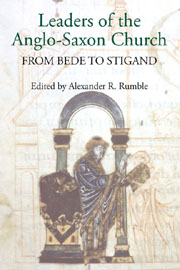Book contents
- Frontmatter
- Contents
- List of Illustrations
- Preface
- Contributors
- Abbreviations
- Introduction: Church Leadership and the Anglo-Saxons
- 1 Bede and the Early English Church
- 2 Archbishop Ecgberht and his Dialogus
- 3 Abbatial Responsibility as Spiritual Labour: Suckling from the Male Breast
- 4 Understanding the Earliest Bishops of Worcester c. 660–860
- 5 The Role of Bishops in Anglo-Saxon Succession Struggles, 955 × 978
- 6 Image-Making: Portraits of Anglo-Saxon Church Leaders
- 7 ‘To Keep Silence Following the Rule's Command’: Bishop Æthelwold, Reforming Ideology and Communication by Signs
- 8 Wulfsige of Sherborne's Reforming Text
- 9 From Winchester to Canterbury: Ælfheah and Stigand – Bishops, Archbishops and Victims
- Index
5 - The Role of Bishops in Anglo-Saxon Succession Struggles, 955 × 978
Published online by Cambridge University Press: 05 February 2013
- Frontmatter
- Contents
- List of Illustrations
- Preface
- Contributors
- Abbreviations
- Introduction: Church Leadership and the Anglo-Saxons
- 1 Bede and the Early English Church
- 2 Archbishop Ecgberht and his Dialogus
- 3 Abbatial Responsibility as Spiritual Labour: Suckling from the Male Breast
- 4 Understanding the Earliest Bishops of Worcester c. 660–860
- 5 The Role of Bishops in Anglo-Saxon Succession Struggles, 955 × 978
- 6 Image-Making: Portraits of Anglo-Saxon Church Leaders
- 7 ‘To Keep Silence Following the Rule's Command’: Bishop Æthelwold, Reforming Ideology and Communication by Signs
- 8 Wulfsige of Sherborne's Reforming Text
- 9 From Winchester to Canterbury: Ælfheah and Stigand – Bishops, Archbishops and Victims
- Index
Summary
Obiit tam inclitus rex .viii. Idibus Iulii; cuius obitu turbatus est status totius regni: commoti sunt episcopi, irati sunt principes, timore concussi sunt monachi, pauefacti populi […]
WITH these words the anonymous author of the Vita Sancti Oswaldi, now believed to be Byrhtferth of Ramsey, depicts the situation after the death of King Edgar in 975. The successions to the Anglo-Saxon kingdom in the second half of the tenth century were indeed quarrelsome. In this chapter, I will try to present the role of the bishops in these succession struggles. I focus on bishops because the organization of the church was probably more sophisticated than that of the lay magnates and the kingdom itself, and thus the bishops could possibly ensure continuity where the laity perhaps was not able to do so. Examining the bishops' activities can give insights into the scope of action they had at their disposal. Furthermore, the incentives for a bishop to decide in favour of one of the candidates will be dealt with, as well as questions such as: Did he act primarily on behalf of his own bishopric? Which factors were involved in his decision? Were some of the bishops responsible for the continuity from one king to his successor? The answers to these questions, as far as the sources provide insights into the events, should shed light on the relationship between bishop and king in Anglo-Saxon England as well as on the issue of the extent to which the bishops in the latter half of the tenth century were not only leaders of the church, but also political leaders.
- Type
- Chapter
- Information
- Leaders of the Anglo-Saxon ChurchFrom Bede to Stigand, pp. 97 - 108Publisher: Boydell & BrewerPrint publication year: 2012



